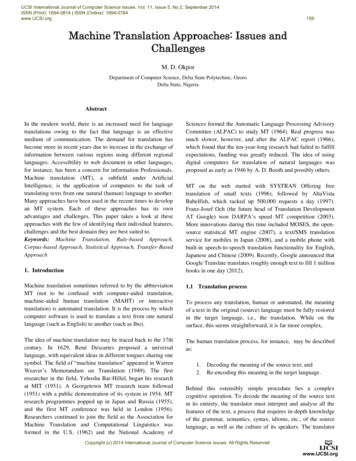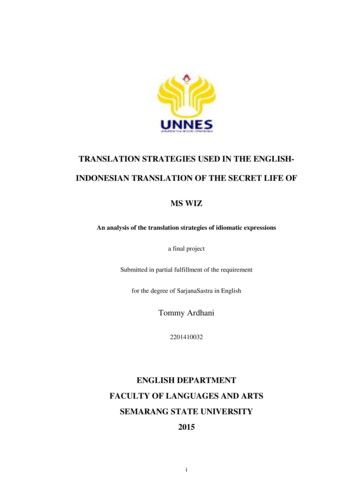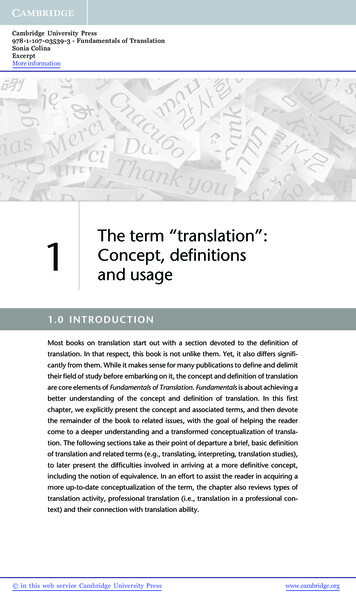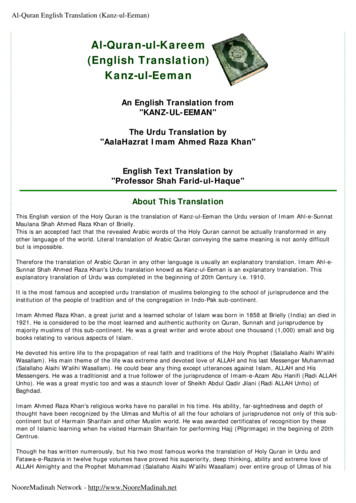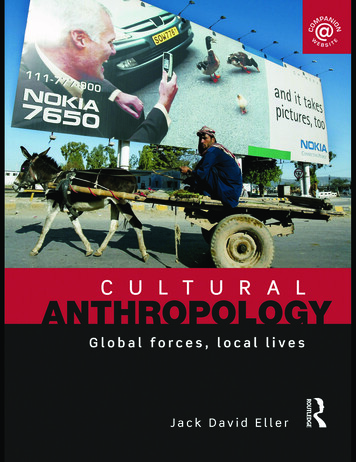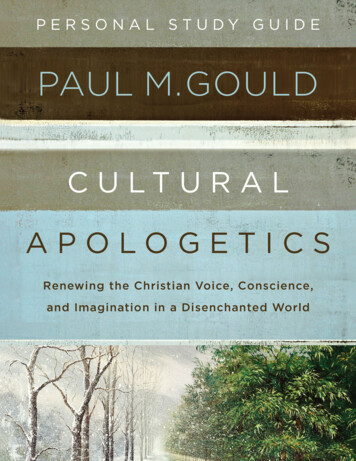
Transcription
International Journal of Linguistics, Literature and Translation (IJLLT)ISSN: 2617-0299 (Online); ISSN: 2708-0099 (Print)DOI: 10.32996/ijlltwww.ijllt.orgResearch ArticleCultural Translation Strategies in Translating Word-Plays in A Series Of Unfortunate Events:Slippery Slope123Wedhowerti *, Anggita Wittaning Putri and Katarina Anggita Rachmaputri1Lecturer, English Letters Department, Sanata Dharma University, Yogyakarta, Indonesia23Student, English Letters Department, Sanata Dharma University, Yogyakarta, IndonesiaCorresponding Author: Wedhowerti, E-mail: wedho.sc@usd.ac.idARTICLE INFOABSTRACTArticle HistoryReceived: July 04, 2020Accepted: August 11, 2020Volume:3Issue: 8DOI: 10.32996/ijllt.2020.3.8.2KEYWORDSCultural translation, translationstrategies, cultural reference,word-playWord-play is one of the biggest challenges in cultural translation due todifferences of cultural references from Source Text (ST) to Target Text (TT). Theresearchers observe this phenomenon by comparing the original and translatedwork of The Slippery Slope, a book of A Series of Unfortunate Events. This studyapplies cultural translation approach and is qualitative in nature. There are fourstrategies employed namely Literal Strategy, Adaptation Strategy, FaithfulStrategy, and Communicative Strategy. Those strategies reveal failures of culturaltranslation from the lack of context and cultural references in the translationproduct, Lereng Licin. The four strategies employed in the TT do not focus ondelivering the cultural references within the ST, making the word-plays losing thesame impact in the translated work. This research offers a source or reference forother researchers interested in cultural translation strategies of works with wordplays.1. Introduction 1Word-play such as acronyms, rhymes, and puns can easily be found in common jokes and literary devices. However, beingcommon does not mean they are easy to understand by people in all cultures. The use of language to give a humorousintention, as in the case of word-plays, tends to give rise to issues in translatability (Delabastita, 1996). There are word-playsbeing difficult to observe even after efforts to translate them to Target Language.The same problem arises in A Series of Unfortunate Events. The series itself has thirteen volumes written by Lemony Snicket(the pen name of Daniel Handler). The volumes were published from 1999 to 2006 by HarperCollins. The series is decoratedwith awards, namely Nickelodeon Kids Choice Award in 2006, and was serialized on Netflix from January 2017 to January2019. Accomplishments aside, the use of complex word-plays with multiple cultural references made this series popular.Unfortunately, however, those references are lost in Indonesian translation written by Primadonna Angela. To narrow downthe scope of this research, the researchers picked the tenth volume of the series, The Slippery Slope, because it has the mostword-play types.The researchers will list the word-plays and its translation, compare the word-plays between the original and translated work,and then analyze them using Cultural Translation Theory, a term first mentioned in an anthropology journal in 1985(Maitland, 2017, p.11) by Bhabha. The researchers deem Cultural Translation suitable to analyze how the Indonesiantranslation of The Slippery Slope cannot deliver cultural references from the Source Text (ST) to the Target Text (TT).Regarding the above matter, this research aims at highlighting cultural translation strategies employed to translate wordplays and reasons why certain translation strategies cannot deliver cultural translation. This research gives a perspectiveregarding cultural translation, especially in a way that it reveals how translation strategies affect cultural translation from STto TT. Accordingly, this research may become a source or reference for other researchers to do the same matter especiallythose interested in cultural translation strategies of works with word-plays.Published by Al-KindiCenter for Research and Development. Copyright (c) the author(s). This is an open access article underCC BY license (https://creativecommons.org/licenses/by/4.0/)10
IJLLT 3(8):10-212. Literature ReviewWord-Play TypesAccording to Pope (2002), the term “word-play” can be defined as a “play” within and around language, with “play” referredas something we do and study, such as jokes and witty remarks in forms of figurative languages (pp. 224-227). Pope suggestsfive types of word-play as follows:a. Sound-playThis wordplay type uses phonology as its main media of “play”. The examples are alliteration, assonance, stress, rhythm,rhyme, and meter. In the research object, the researchers found rhyme and alliteration fits into the category of sound-playwithin the data. Rhyme itself is a condition where there are the same or similar sounds found in a group of words, whilealliteration is a specific-type of rhyme where the rhyme only happens at the beginning of the words.b. Visual-playThis wordplay type dabbles with aesthetical aspects of the words. It manipulates letters, shapes, spaces and colors of thewords and its surrounding area. The easiest example that we can find in daily life is a logo.c. Lexical (“Word”) PlayThis wordplay type displaces and chops individual words to create another meaning. Since it plays around meaning, especiallythe signified and signifier, lexical play explores the semantic features of words. The most common example, as well as one ofthe word-play found in the research object, is pun. Pun itself is a combination of different types of word-play, rhymes orwords with similar meanings for instance, to create a logical connection.d. Structure PlayThis wordplay type manipulates the whole structure of the phrase instead of individual components (such as a singlephonetic, visual aspect, or word). It uses syntax and cohesion as its media of “play”.e. Contextual and IntertextualityThis wordplay type needs one’s understanding of the genres and contexts used as reference. One of the common examplesof contextual and intertextual play is acronym, which is the shortened version (using the initial letters or parts of each word)of the original words. Acronym is also one of the most common wordplay found within the research subject and, as thetheory proven, causes confusions due to the lack of context.Translation StrategiesKrings (1986) defines translation strategies as “translator's potentially conscious plans for solving concrete translationproblems” while translating ST to TT (in Shaheri & Satariyan, 2017). Newmark (1988) declares eight Translation Strategies (pp.45-47), which are:a. Word-for-Word TranslationThis strategy translates ST to TT from one individual word to another.b. Literal TranslationThis strategy translates by retaining TL structure but ignores context by choosing the most literal words possible.c. Faithful TranslationThis strategy translates both the structure and context from SL to TL but left cultural words as is. This makes FaithfulTranslation an improved, but imperfect version of Literal Translation.d. Semantic TranslationThis strategy translates by retelling SL by the translator using TL. That means, this strategy mainly relies on the creativeinterpretation of the translator.e. Adaptation TranslationThis strategy transforms all cultural aspects of SL to TL’s but preserving other aspects. This strategy is often used for literaryworks, especially plays – where the characters, plot, and theme of the story is preserved but reinstituted to culturalbackgrounds fitting to Target Readers.11
Cultural Translation Strategies in Translating Word-Plays in A Series Of Unfortunate Events: Slippery Slopef. Free TranslationThis strategy translates by purely retelling without preservation of writing style, making the TT more of a review rather than atranslation.g. Idiomatic TranslationThis strategy translates by adding colloquialism and idioms within the TT to explain parts of ST, though the ST itself uses noidioms. The idioms are meant to deliver the message of ST. However, this strategy often results in inaccurate translation, as itdistorts the nuances of meaning from ST.Communicative TranslationThis strategy engages readers with as much context as possible on the cultural references. Therefore, the TT is“communicative” because it engages the Target Readers to understand the contexts provided by ST.Cultural TranslationCultural translation term is a term that was first coined by Bhabha, who proposes that it is “the performative nature ofcultural communication” (1994, p. 228). Maitland defines cultural translation as the interpretation of a text to be understood,which involves “the incorporation of the text within the sociocultural context of the translator” (2017, p. 10). In other words,cultural translation is a translation process that does not only deliver the lexical meaning from the ST to TT, but also thecultural references and experiences.This theory is important because every translated work is culture-bound or cannot be separated with the context of the SL(Bassnett, 2012, pp. 19-20). Since culture is a manifestation that is peculiar to a community that uses a particular language asits means of expression, we cannot separate the culture from SL text with the translation result in TL (Newmark, 1988, p. 94).Therefore, inevitable issues often arise during the process of translating a text from the SL into the TL (Munday, 2016, inSyed, 2017, p. 78).One example from A Series of Unfortunate Events: The Slippery Slope is the phrase “Mata Hari”. In the ST (English), “MataHari” was meant to be a reference to a spy in WWI. However, since it is left untranslated in TT (Indonesian), that context doesnot appeal the same way because Indonesian readers are lacking it. Not only that, but it also created a misunderstandingbecause there is “matahari” in Indonesian vocabulary, which means ‘the sun’ and read the same way as “Mata Hari” despitedifferences in orthography.2. MethodologyFollowing the objective to see the translation strategies used in the data source, this research uses two objects. The first isThe Slippery Slope written by Daniel Handler (or often referred by his pen-name Lemony Snicket). This work was published in2003 by HarperCollins and is the tenth of thirteen books in A Series of Unfortunate Events. The series itself had beentranslated into Indonesian – which is the second object of this study. The translated version itself was published in 2008 inthe name of Lereng Licin. The translation work is done by Primadonna Angela published by PT. Gramedia Pustaka.Set around in the 20th Century (the exact dates unknown), A Series of Unfortunate Events told a story of Violet, Klaus, andSunny Baudelaire, three recent orphans who periodically change guardians thanks to the miseries brought by Count Olaf, aman who is after their inheritance. These misfortunes are told by Snicket himself, posing as a narrator using word-plays asone of the shining elements of the recount. Some of these word-plays are transferred into the translated version, but theirpunch as word-plays are mellowed or even lost in it.This study applies cultural translation approach to analyze the objects and is qualitative in nature. The approach is chosenbecause translation itself is closely related to cultural studies (Bassnett & Lefevere, 1998, p.125). In fact, Bassnett suggeststhat both studies influence one another since they depart from the same concern; “power relation and textual production”(1998, p.135). Power relation indicated here is the social struggles portrayed within the text, while textual production is theworks created based on those struggles. Therefore, to analyze a translated work, it is necessary to analyze the culturalreferences of the power relation of the source and target languages.Since many instances of word-plays in the text rely on cultural references that are familiar to English-speaking readers but notto Indonesian-speaking readers, the cultural translation approach is then suitable for this study. With the approach, it ispossible to relate the cultural references to the word-play types and translation strategies used in the TT.2.1 Population and SampleThe population of this research is the whole series of A Series of Unfortunate Events. However, the series has thirteen booksin which word-plays are used. Therefore, the tenth book The Slippery Slope is used as a sample as this particular book has the12
IJLLT 3(8):10-21most variance of data-in-demand within the series, as observed by the researchers. Then, based on the data gathered fromthe sample, the researchers choose 30 selected data to represent the data population within The Slippery Slope.2.2 Data Collection InstrumentsFirstly, the researchers will identify the word-play types as suggested by Pope (2002) of the gathered data. The types are asfollows:Table 1. Pope’s Word-Play Types (2002)NoWord-Play Types1Sound Play2Visual Play3Lexical (‘Word’) Play4Structure Play5Contextual and IntertextualityTable 1 lists the word-play types as proposed by Pope (2002). The contents of this table will be used as the reference whenidentifying the types of gathered word-play in Table 3. After identifying word-play types, the researchers will then compareword-plays from ST and TT and list the translation strategies by Newmark (1988). The strategies are presented as follows:Table 2. Newmark’s Translation tive
Cultural Translation Strategies in Translating Word-Plays in A Series Of Unfortunate Events: Slippery SlopeTable 2 lists the translation strategies by Newmark. The contents of this table will be used as the selection of translationstrategies of the word-play translations in Table 3. Lastly, the research will use Table 1 and Table 2 to make the complete listof the chosen data as shown below:Table 3. Data ComparisonNoSTTTWord-Play TypeStrategy1 you are pretty and I’mlonely. Now, I’m prettylonely. kau sangat cantik dan akukesepian. Sekarang, aku sangatkesepian.Lexical PlayLiteral2Mortmain MountainPegunungan PortmainSound PlayLiteral3Esme SqualorEsme SqualorLexical PlayFaithful4Caligari CarnivalKarnival KarnivoraSound PlayAdaptation5V.F.D.P.K.S.Contextual andIntertextualityLiteral6NonatGak ada seranggaLexical PlayLiteral7Lucky Smells LumbermillPabrik Kayu Pasti MujurSound PlayAdaptation8The Daily PunctilioHarian TerkiniLexical PlayAdaptation9XenialXenophobiaContextual al PlayCommunicativeTable 3 will be used to identify both the word-play type and their translations strategies. This table will help the researchersanalyze the issues of the translation strategies according to cultural translation theory.3. Results and Discussion3.1. Translation Strategies in The Series of Unfortunate Events: Slippery SlopeTable 4. Datum 1No1ST you are pretty and I’mlonely. Now, I’m prettylonely.TT kau sangat cantik dan akukesepian. Sekarang, akusangat kesepian.Word-Play TypeStrategyLexical PlayLiteralThe first datum is classified as Lexical Play type because the phrases in ST form a pun from the word pretty, which wasattempted to be replicated with the word sangat in TT. However, as ‘pretty’ and ‘sangat’ have different meanings within thecontext, the TT then is classified with literal translation strategy since the translator prioritized the structure of the phrases toreplicate the structure rather than the pun nor the meaning of the pun-words themselves. Longman Dictionary (2001) defines‘pretty’ into three meanings that may suit the context of the datum: one is ‘good looking’ to refer to the first mention of‘pretty’ in ST, and the other is either ‘fairly, though not completely’ or ‘very’ for the second mention. Tracing from thesepossible definitions, it is clear that the translator chose the meaning ‘very’ (which is equivalent to Bahasa Indonesia ‘sangat’)to redeliver the phrase structure in TT. While this works for the second phrase where both ‘sangat’ and ‘pretty’ are adverbs,the first phrase loses its pun effect because ‘pretty’ is directly translated to ‘cantik’ with the addition of ‘sangat’ before it toretain the sentence structure.14
IJLLT 3(8):10-21Table 5. Datum 2No2STMortmain MountainTTPegunungan PortmainWord-Play TypeStrategySound PlayLiteralSimilar to the first datum, the second datum also applies literal translation strategy to retain the structure of the phrase. Inthis case, the alliteration pattern is the focus of the structure, as observed by how the mountain’s name is changed toPortmain to rhyme with ‘Pegunungan’. However, similarly to the first datum, the translation result in this datum loses its puneffect and its meaning by extension.Many names in The Series of Unfortunate Events have some sort of cultural references, either from the meaning of the nameitself or certain things within the culture that may inspire it. ‘Mortmain Mountain’ follows this pattern, as ‘Mortmain’ has themeaning ‘an inalienable possession’ (Merriam-Webster Online Dictionary) befitting for a giant, immovable mountain. Bytransforming ‘Mortmain’ into ‘Portmain’ in TT, the mountain loses its solid impression, as ‘Portmain’ holds no meaning at allin both English and Indonesian.Table 6. Datum 3NoST3TTEsme SqualorEsme SqualorWord-Play TypeStrategyLexical PlayFaithful‘Squalor’ is yet another pun in The Series of Unfortunate Events. According to Longman Dictionary (2011), the word means‘the condition of being squalid’, with squalid itself defined as ‘involving low moral standards or dishonesty’ which sums up thecharacterization of Esme Squalor herself. Therefore, English-speaking readers will have zero difficulty digesting Esme’stendency to drive the Baudelaire siblings to forced labor, her betrayals in the previous book The Ersatz Elevator, and hercriminal actions with instant wealth in mind. However, as it is left untranslated in TT, Target Readers are likely to see ‘Squalor’as another foreign name and therefore missing the characterization hint.Table 7. Datum 4No4STCaligari CarnivalTTKarnival KarnivoraWord-Play TypeStrategySound PlayAdaptationThis datum holds pop and historical culture reference that is lost in translation. ‘Caligari’ is a reference to The Cabinet of Dr.Caligari, the first German Expressionist film released in 1920. Popular for boosting German cinematic industry post WorldWar I and surrealistic settings (Pfeiffer, 2016), The Cabinet of Dr. Caligari carries bizarre and eerie themes throughout themovie, perfect to describe how the vibe Caligari Carnival was described in the previous book The Carnivorous Carnival.Relating to the mentioned book, it is easy to see where the translator took ‘Karnivora’ from, but it is still worth mentioningthat the mood from ‘Caligari’s reference is lost in TT.Table 8. Datum 5No5V.F.D.STTTP.K.S.Word-Play TypeStrategyContextual andIntertextualityLiteralV.F.D. is the most recurring abbreviation in The Series of Unfortunate Events as well as an important plot device surroundedwith mystery. Not to mention, it is also used as codes throughout the series, meaning that the translation has to beconsistent for the sake of later codes. As it is an abbreviation, the datum is classified to the Contextual and Intertextualitytype. Though the forms of the abbreviations are different, they are used consistently, following the words they stand for. InST, VFD stands for Volunteer Fire Department, while in TT it is translated to Pemadam Kebakaran Sukarelawan (PKS forshort). In The Slippery Slope itself, there are several codes that used these abbreviations, such as Valley of Four Drafts(translated to Padang Keempat Sumberangin in TT) and Verbal Fridge Dialogue (translated to Percakapan Kulkas Sandi).However, it is noted that there are some codes that are left untranslated (such as Vertical Flame Diversion), repeated (such as15
Cultural Translation Strategies in Translating Word-Plays in A Series Of Unfortunate Events: Slippery SlopePasukan Kebekuan Seram for Violent Frozen Dragonflies and Voracious Fierce Dragon), or modified to fit the abbreviation(such as the translation of Very Fresh Dill to Peterseli Kualitas Segar) that cause Cultural Translation problems which will beexplored in the second section of this chapter.Table 9. Datum 6No6STNonatTTGak ada seranggaWord-Play TypeStrategyLexical PlayLiteralThis particular datum was taken from Sunny Baudelaire, the youngest Baudelaire sibling that spoke broken utterances as hertrademark throughout the series. Her utterances are designed to sound gibberish and meaningless, just like baby-talk, to fither image as a toddler. However, the words actually contain her intentions and can be understood as such, given that onecan decipher her utterances and connect them to their references.This datum is one of the easiest examples of her utterances: “nonat” is a phonetic transcription of “no gnat”, which can beliterally translated to 'gak ada serangga' in TT. While the translation product cannot mimic the phonetic transcription used inST, the use of informal form in TT is capable of replicating the baby-talk to a degree. After all, children develop language skillsfrom informal language activities instead of informal (Follari, 2006, p. 260), so the use of informal ‘gak ada’ instead of formal‘tidak ada’ sounds natural for Sunny Baudelaire without diminishing her trademark. However, TT does make the context andmeaning of her utterance clearer by brandishing a whole phrase instead of replicating the phonetic transcription in ST. As aresult, Sunny Baudelaire appears to be more eloquent in TT compared to ST.Table 10. Datum 7No7STLucky Smells LumbermillTTPabrik Kayu Pasti MujurWord-Play TypeStrategySound PlayAdaptationThe seventh datum used adaptation strategy because there is no equivalence for ‘lucky smells’. The words themselves haveno specific meaning, similar to many common lumber mills names from The United States. Therefore, the translator took theliberty to adapt the name to something similar to common lumber mills in Indonesia while maintaining the existence of therhyme in the translation result. Since there is no specific meaning in “lucky smells” nor “pasti mujur”, the adaptation did nothinder the fact that both names are ironic, given that the lumber mill has a tragic backstory explained in a previous book, TheMiserable Mill.Table 11. Datum 8No8STThe Daily PunctilioTTHarian TerkiniWord-Play TypeStrategyLexical PlayAdaptationPunctilio, or its adjective form punctilious, means “being very careful to behave correctly and keep exactly to rules” (LongmanDictionary 2011). This particular meaning is ironic when we see the contents of the newspaper in the series, which are oftenfull of slander and bias without citing any reliable sources. As we can observe in the TT, this irony is lost because there's noequivalence of punctilio. “Terkini” does not give any contribution to the irony either because the paper did present up-todate news in the series, but the contents are still questionable otherwise.Table 12. Datum 9No9XenialSTTTXenophobiaWord-Play TypeStrategyContextual andIntertextualityAdaptationThis datum is a part of Klaus' suggestion to the Snow Scout Alphabet Pledge, a pledge consisting of consecutive wordsbeginning with the letters in the alphabet. One thing to note from this pledge is that its content does not make sense. Asexplained from page 71 in the ST, there are some words that are contradictory (“calm” and “meek” to ‘frisky” and “jumping”;“every morning”, “every afternoon”, “every night”, and “all day long”) that they are impossible to do at the same time, a16
IJLLT 3(8):10-21given fact to the scouts who are children (“human” and “young”) therefore redundant, or simply impossible to do('xylophone').“Xylophone” is the word Klaus suggested on. In page 71 of ST, the Baudelaires are confused why the word is in the pledge tobegin with, given that the meaning is “a musical instrument which consists of metal or wooden bars that you hit with aspecial stick to make sounds” (Longman Dictionary, 2011) - something impossible for the scouts to be. He then suggested“xenial” in ST, which according to the Merriam-Webster dictionary means “hospitable to strangers” (“Xenial”, n.d.) makesmore sense to be in the pledge because it reflects good conduct for the scouts, not to mention has similar meaning to otherwords in the pledge such as “accommodating”. This suggestion, however, was shot down by the guardian of the scout UncleBruce before Klaus could tell them the meaning of “xenial”. Therefore, changing “xenial” to “xenophobia” will not affect theplot as the meaning of the words will not be told anyway, but the fact that it is does clash with the context becausexenophobia has the opposite meaning to xenial (“extreme fear or dislike of people from other countries” (LongmanDictionary 2011).)Table 13. Datum 10No10RosebudSTTTRosebud*Word-Play TypeStrategyLexical PlayCommunicativeAs the TT explained in the footnote, “Rosebud” is a reference to Citizen Kane, a popular mystery film released in 1941. To beprecise, it is the last word of Charles Foster Kane, a former influential newspaper publisher, with meaning itself leftunexplained with mysteries entailing it. In the story, however, it was one of Sunny's baby-talk. On page 321 of ST, afterSunny mentioned the word, it is explained afterwards that “In some situations, the location of a certain object can be muchmore important than being outnumbered”. This explanation parallels what happens in the story (the Baudelaires and QuigleyQuagmire cornered by the villains, extorted for a key item in the story, the sugar bowl) and what happens in Citizen Kane. Inthe film, Thompson the journalist tried to pinpoint the meaning of “Rosebud” by asking Kane’s acquaintances to no avail. Ashe gives up on his pursuit, the scene moves to workers in Kane’s mansion burning invaluable items, one being a sled with theword “Rosebud” on it - which was mentioned by the people Thompson asked when they recounted Kane’s childhood (Welles,1941).The parallel here is that the item (the sled in Citizen Kane and the sugar bowl in The Slippery Slope) is the true key of thestory, not necessarily the people in concern. ST readers will be able to understand this parallel, given Citizen Kane'severlasting popularity. The film had received numerous awards from 1941 to 2012, notably receiving nine Oscar awards atonce in 1942 (“Citizen Kane (1941)”, n.d.), and had many articles explaining the meaning of “Rosebud” alone. It isunderstandable that the datum was left untranslated, as the reference is very specific. However, TT readers will havedifficulties understanding the reference since the film is not popular in Indonesia. Even if the reader tries to find informationor watch Citizen Kane, they may not understand what the reference is trying to present, since that “Rosebud” itself is amystery.3.2 Cultural Translation Revealed in The Series of Unfortunate Events: Slippery Slope Translation StrategiesFrom the chosen data, only four out of seven translation strategies are used. Statistically, Literal and Adaptation TranslationStrategies are used more compared to Faithful and Communicative Strategies. However, each strategy is applied to differenttypes of Word-plays, then given different effects to the translation result in stretch. Below are the translation strategies fromthe most to least used and exploration of the cultural effects of the translation results.Literal StrategyThere are four data using this strategy; two lexical play, one sound play, and one contextual and intertextuality word-play.Each of these data received different effects from the chosen translation strategy, but they generally lose important elementsfrom ST. The Lexical Plays, for one, sacrifices the pun for the sake of consistency. As mentioned in the Introduction section,The Series of Unfortunate Events used word-plays (such as puns) throughout the books, making it one of an importantelement that constitutes the writing and story-telling style. The writer specifically used puns to describe things or peoplewithin one to a few words (see The Third Datum), letting the plot advance without being too heavy on character descriptionsbut not leaving context and hints of the characterizations itself. Therefore, by eliminating this aspect, many contexts are lostin TT. Another thing to mention is that pun is a part of English humor (Pope, 2002, p. 223), so eliminating them alsoeliminates the cultural influence of the work. In The First Datum, the pun of ‘pretty’ was replaced with repetition of ‘sangat’17
Cultural Translation Strategies in Translating Word-Plays in A Series Of Unfortunate Events: Slippery Slopeto consistency of the phrase structures. While the context of the pun is not lost (because the meaning ‘beautiful’ is still there,translated to ‘cantik’), the writer’s original style is inevitably lost. The loss is more apparent in The Sixth Datum; applyingLiteral Strategy to the datum reduces Sunny Baudelaire’s character quirk to nothing. Again, the context of the datum itself isnot lost (‘nonat’ is just a reduced version of ‘no gnat’, literally translated to ‘gak ada serangga’), but Sunny’s character suffersfrom this strategy.Similar to problems faced by the Lexical Plays, the Sound Play also suffers from context. However, there is another element inconcern; alliteration. As observed from The Second Datum, the translator maintained the consistency of the alliteration in TTwhile sacrificing the meaning of ‘Mortmain’. This became a problem because by losing the context of ‘Mortmain’, TT alsoreceives no Cultural Translation because the word and context itself is altered into something meaningless in both Source andTarget Language. Additionally, all names used in The Series of Unfortunate Events have western roots and/or influence. At thevery least, if the Target Reader wants to learn
2003 by HarperCollins and is the tenth of thirteen books in A Series of Unfortunate Events. The series itself had been translated into Indonesian - which is the second object of this study. The translated version itself was published in 2008 in the name of Lereng Licin. The translation work is done by Primadonna Angela published by PT.
